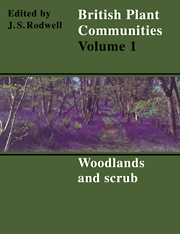Book contents
- Frontmatter
- Contents
- List of Figures
- Foreword
- Preface and Acknowledgements
- Preamble
- General Introduction
- Woodlands and Scrub
- Introduction to Woodlands and Scrub
- Key To Woodlands and Scrub
- Community Descriptions
- W1 Salix Cinerea-Galium Palustre woodland
- W2 Salix Cinerea-Betula Pubescens-Phragmites Australis Woodland
- W3 Salix Pentandra-Carex Rostrata Woodland
- W4 Betula Pubescens-Molinia Caerulea Woodland
- W5 Alnus Glutinosa-Carex Paniculata Woodland
- W6 Alnus Glutinosa-Urtica Jzozca Woodland
- W7 Ainus Glutinosa-Fraxinus Excelsior-Lysimachia Nemorum Woodland
- W8 Fraxinus Excelsior-Acer Campestre-Mercurialis Perennis Woodland
- W9 Fraxinus Excelsior-Sorbus Aucuparia-Mercurialis Perennis Woodland
- W10 Quereus Robur-Pteridium Aquilinum-Rubus Fruticosus Woodland
- W11 Quereus Petraea-Betula Pubescens-Oxalis Acetosella Woodland
- W12 Fagus Sylvatica-Mercurialis Perennis Woodland
- W13 Taxus Baccata Woodland
- W14 Fagus Sylvatica-Rubus Fruticosus Woodland
- W15 Fagus Sylvatica-Deschampsia Flexuosa Woodland
- W16 Quereus spp.-Betula spp.-Deschampsia Flexuosa Woodland
- W17 Quereus Petraea-Betula Pubescens-Dicranum Majus Woodland
- W18 Pinus Sylvestris-Hylocomium Splendens Woodland
- W19 Juniperus Communis Ssp. Communis-Oxalis Acetosella Woodland
- W20 Salix Lapponum-Luzula Sylvatica Scrub
- W21 Crataegus monogyna-Hedera helix scrub
- W22 Prunus Spinosa-Rubus Fruticosus Scrub
- W23 Ulex Europaeus-Rubus Fruticosus Scrub
- W24 Rubus Fruticosus-Holcus Lanatus Underscrub
- W25 Pteridium Aquilinum-Rubus Fruticosus Underscrub
- Index of Synonyms to Woodlands and Scrub
- Index of Species in Woodlands and Scrub
- Bibliography
W7 - Ainus Glutinosa-Fraxinus Excelsior-Lysimachia Nemorum Woodland
Published online by Cambridge University Press: 04 July 2020
- Frontmatter
- Contents
- List of Figures
- Foreword
- Preface and Acknowledgements
- Preamble
- General Introduction
- Woodlands and Scrub
- Introduction to Woodlands and Scrub
- Key To Woodlands and Scrub
- Community Descriptions
- W1 Salix Cinerea-Galium Palustre woodland
- W2 Salix Cinerea-Betula Pubescens-Phragmites Australis Woodland
- W3 Salix Pentandra-Carex Rostrata Woodland
- W4 Betula Pubescens-Molinia Caerulea Woodland
- W5 Alnus Glutinosa-Carex Paniculata Woodland
- W6 Alnus Glutinosa-Urtica Jzozca Woodland
- W7 Ainus Glutinosa-Fraxinus Excelsior-Lysimachia Nemorum Woodland
- W8 Fraxinus Excelsior-Acer Campestre-Mercurialis Perennis Woodland
- W9 Fraxinus Excelsior-Sorbus Aucuparia-Mercurialis Perennis Woodland
- W10 Quereus Robur-Pteridium Aquilinum-Rubus Fruticosus Woodland
- W11 Quereus Petraea-Betula Pubescens-Oxalis Acetosella Woodland
- W12 Fagus Sylvatica-Mercurialis Perennis Woodland
- W13 Taxus Baccata Woodland
- W14 Fagus Sylvatica-Rubus Fruticosus Woodland
- W15 Fagus Sylvatica-Deschampsia Flexuosa Woodland
- W16 Quereus spp.-Betula spp.-Deschampsia Flexuosa Woodland
- W17 Quereus Petraea-Betula Pubescens-Dicranum Majus Woodland
- W18 Pinus Sylvestris-Hylocomium Splendens Woodland
- W19 Juniperus Communis Ssp. Communis-Oxalis Acetosella Woodland
- W20 Salix Lapponum-Luzula Sylvatica Scrub
- W21 Crataegus monogyna-Hedera helix scrub
- W22 Prunus Spinosa-Rubus Fruticosus Scrub
- W23 Ulex Europaeus-Rubus Fruticosus Scrub
- W24 Rubus Fruticosus-Holcus Lanatus Underscrub
- W25 Pteridium Aquilinum-Rubus Fruticosus Underscrub
- Index of Synonyms to Woodlands and Scrub
- Index of Species in Woodlands and Scrub
- Bibliography
Summary
Synonymy
Alder woodland types lb, lc p.p. & 2b p.p. McVean 1956b; Pellio-Alnetum Klötzli 1970 p.p.; Crépis paludosa-Alnus glutinosa Association Birse 1980; Alder stand types 7Aa, 7Ab, 7Bc, 7D & 7Eb Peterken 1981; Woodland plot types 12, 13, 14 & 16 Bunce 1982.
Constant species
Alnus glutinosa, Filipendula ulmaria, Lysimachia nemorum, Eurhynchium praelongum.
Physiognomy
The Alnus glutinosa-Fraxinus excelsior-Lysimachia nemorum woodland typically has a somewhat open and, in slope-flush stands, rather irregular canopy of trees. Alnus glutinosa is the only woody constant throughout and, on more secure substrates, it can reach a grand stature with multiple stems and numerous small suckers and be an overwhelming dominant. Very frequently, however, there is some Fraxinus excelsior in the canopy and, rather less commonly, some Betula pubescens (only rarely B. pendula) and both of these can attain prominence in a more mixed cover of trees. Acer pseudoplatanus occurs occasionally where the ground is not permanently moist. Sometimes, larger specimens of Salix cinerea and S. caprea break the main canopy tier. Although edaphic conditions here are often suitable for Q. robur, this is predominantly a north-western woodland type and the species is rather scarce. Q. petraea can occur occasionally, though it is very much limited to the less strongly gleyed soils of the Deschampsia subcommunity. Slumping flushes carrying this woodland are sometimes overhung by trees rooted in the drier ground of the surrounding woodland.
There is usually an understorey in this community but its cover, height and composition are rather variable. Corylus avellana, Crataegus monogyna and Salix cinerea are the most frequent species overall and each can be abundant but the first two tend to be very poorly represented on periodically-flooded alluvial flats and confined to more stable and drier areas in slope flushes S. cinerea, by contrast, is commoner in wetter situations. Sorbus aucuparia and Sambucus nigra occur occasionally, the former tending to follow Corylus and Crataegus, the latter more often associated with S. cinerea. Other species that may be encountered are Ilex aquifolium, Viburnum opulus, Prunus spinosa and P. padus, the last sometimes with striking local abundance. Saplings of the main canopy trees are common with young Fraxinus and A. pseudoplatanus being especially frequent and abundant, Alnus and Betula rather less so. Where there is a tall tier of trees, these smaller woody elements may form a quite well defined understorey; in other stands, the layers tend to merge indistinctly.
- Type
- Chapter
- Information
- British Plant Communities , pp. 102 - 112Publisher: Cambridge University PressPrint publication year: 1991

